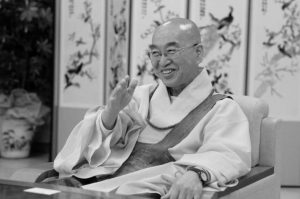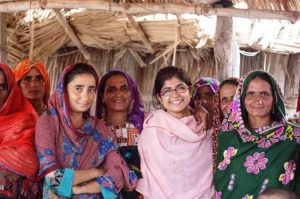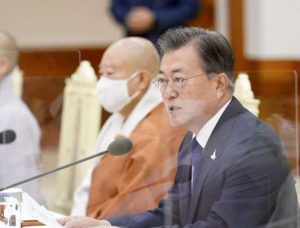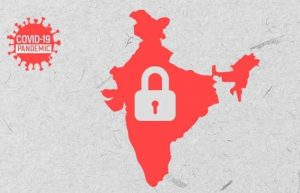
The transmission of Dharma requires language, encounter, and human relationships. This may seem a very obvious point, but in practice, a fruitful meeting with the Dharma is far from being a universal fact of experience and is closely tied up with karma and merit…Some people find the Dharma easily and progress swiftly; others find it only rarely and with great difficulty; some encounter it and fail to recognize its worth. And there are some who never find it.*
I met the dharma in my early 20s, through Reverend Taitetsu Unno, a leader in the Jodo Shinshu Pureland School. But it was not until my late 20’s that I began reading Vajrayana texts and a budding connection to Tibetan Buddhist teachings developed. After reading these texts nightly for two years, at age 28, I began making fervent prayers to meet a real human teacher. I felt that without one, I could not really begin to deepen and embody the rich Buddhadharma in their pages.
After two years of searching, I met Mindroling Khandro Rinpoche at a large event in Austin, Texas. I liked her way very much, but did not feel she was my teacher per se. Shortly after this, I heard there would be a teaching by someone named Tulku Thubten Rinpoche—now Anam Thubten—and I signed up for the retreat, a gathering of only 10 or 11 people. I took refuge that weekend, in a small ceremony for four people. From that point on, everything changed. After only a few months studying with Tulku Thubten, he sent me to meet Lama Tsedrup Tharchin Rinpoche, in the Santa Cruz mountains of California. I thereafter met many important and kind lamas, including Lama Yeshe Wangmo, who over the years has shared many teachings and herself been a keen example of devotion and perseverance on the path.

We all know that feeling when a kind of flow takes over, and we start to make actions and choices that seem predestined, beyond our mere ego’s decision-making. We could call these choiceless choices. These have happened to—with? for?—me many times in the context of dharma practice, meeting teachers, or engaging in retreats. Meeting Lama Tharchin Rinpoche was one such moment, where everything changed for me. He became my root Lama and the center of my path of practice for the rest of my life. But back then, I did not yet know all that would unfold. Also, it was extremely inconvenient for my tidy, accelerating, ordinary life in the world, to suddenly change course and engage with frequent retreats, which became longer over time.
Students of the buddha dharma span many paths, schools, and traditions. Practitioners have a huge variety of experiences with their practice, and with their teachers. I count myself extremely fortunate to have very positive experiences with all my Dharma teachers, including the challenges of faith and commitment that mark any essential life relationships in which we might engage. I believe myself to be among the most fortunate as I have encountered—perhaps re-met—Vajrayana teachings through the Nyingma school’s Dudjom Tersar lineage, with living student-teacher relationships with some of the keenest and most realized teachers in human form. They have taught and guided me with great patience and skill.
I realize that many people never meet wisdom beings in this life. Or they may meet charlatans or those of weak character who lead them astray by being untrustworthy. Although the latter receive much publicity, they are the minority of instances. In my experience and those of my many dharma friends, the norm is finding lamas who are worthy of emulation, respect, and reliance on the path of transforming and liberating one’s mindstream through practice. I feel my blessings every day, which must only come from previous lives’ merit and positive karmic connections. I certainly have much room for improvement with both diligence and focus!

My root lama spent his whole life, from age eight onward, as a devout student of his lama, Kyabje Jigdrel Yeshe Dorje (Dudjom) Rinpoche, along with Thinley Norbu Rinpoche, and so many other esteemed, incomparable lamas. Though I did not meet His Holiness Dudjom Rinpoche in this lifetime, I have been fortunate to spend 11 and 13 years, respectively, receiving teachings and blessings from both Thinley Norbu Rinpoche and Lama Tharchin Rinpoche, both sublime dharma heirs of His Holiness, as well as Dudjom Sangye Pema Shepa Yangsi Rinpoche, before his untimely passing last winter.
In the early days, I studied The Words of My Perfect Teacher (Yale University Press 2010), an essential book I return to again and again. The Words of My Perfect Teacher manual recounts all the areas of study and approach—it is a Vajrayana bible, if you will. My teachers are and have all been perfect, even with their human imperfections. As beauty is in the eye of the beholder, so perfection is in the projection or dak nang, pure vision, of the viewer/experiencer. This is not to say one must endure abuse or transgressions, not at all. But barring those, the teacher need not be some idyllic being free from ordinary habits, burping, off-color jokes, or mood swings. We need not understand all their actions if we perceive their motivation to be pure and we have given sufficient time and energy toward examining their character and consistency.

The foundation of the Vajrayana path of practice is the Ngondro, or preliminary practices, which form the basis of the beginning of the path and the initial teachings which are given to and practiced by newcomers. Ngondro purifies years, or lifetimes, of obscuring habits, and focuses our energy on devotion and discipline. Whether or not a person does 100,000 repetitions of each of the sections of the Ngondro, the purpose is to form a foundation on which all further practices will be based: just like the foundation of a house is essential to all further floors built. The heart of Ngondro is guru yoga—the key to unlock the door to awakening. Guru yoga is the enactment of a disciple blending one’s mindstream with that of the teacher. The teacher is a symbol or embodiment of Guru Rinpoche, or the Buddha, or Kuntuzangmo—all forms of primordial wisdom-compassion.

It is said that a student and teacher must examine each other for a minimum of two to three years before engaging in study, contemplation, empowerments, hearing the teachings, and practicing the Dharma. If this effort is invested, then a true bond can be formed based on the confidence of trust. This is the opposite of blind faith or blind trust. Instead, one uses discernment, examination, and intuition to be sure that the teacher—or student—is reliable. This is different than forming a friendship or liking a personality, but rather determining that a person is truly reliable. They should possess a steady presence, awakened qualities, and guide students without their own self-interest interfering in teaching. This cultivates an increasing self-confidence or vajra pride—as opposed to ordinary pride—in the student. Ideally, this relationship is a lifelong commitment, both like and unlike a marriage of sorts. As Dzongsar Khyentse Rinpoche explains, this relationship is in fact even more important than that of a spouse, as it intends to lead us to awakening our true nature. Rinpoche gives a detailed exposition of the benefits and perils of the teacher-student relationship in his illuminating and timely book, Poison is Medicine: Clarifying the Vajrayana (Siddhartha’s Intent 2021).**
Ideally, the faith and capacity for reliance is lifelong, even if teacher and student meet only one time. The basis of this relationship is to instill and blossom the Buddha Dharma from one person to the next as an inheritance: dharma legacy is passed from teacher to student, in an unbroken lineage of ear-whispered teachings and instruction.
In Part Two next month, I will delve more into guru devotion, through the life of Yeshe Tsogyal, foremost student of Guru Rinpoche, herself a realized teacher. May all beings be free, through realizing their true nature.

* Lady of the Lotus-Born -The Life & Enlightenment of Yeshe Tsogyal, Changchub & Nyingpo, Shambhala, 2002, xviii.
** Poison is Medicine | Dzongsar Khyentse Rinpoche’s New Book (Khyentse Foundation)
Related features from BDG
A Journey Through the Guru’s Name Mantra
Demystifying the Yoga of Bliss: An Interview with Dr. Nida Chenagtsang, Part One
Who is the Guru? Accessing Inner Wisdom When the Teacher Has Passed
Poison Is Medicine: Paradox and Perception in Vajrayana Buddhism
The Flourishing of the Palyul Tradition in Bulgaria
Lama Palden Drolma: Transmitting the Teachings to the West












